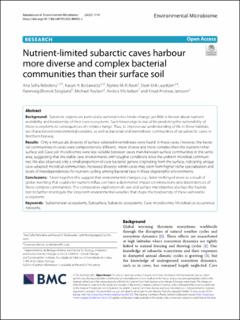| dc.contributor.author | Reboleira, Ana Sofia | |
| dc.contributor.author | Bodawatta, Kasun H. | |
| dc.contributor.author | Ravn, Nynne M. R. | |
| dc.contributor.author | Lauritzen, Stein Erik | |
| dc.contributor.author | Skoglund, Rannveig Øvrevik | |
| dc.contributor.author | Poulsen, Michael | |
| dc.contributor.author | Michelsen, Anders | |
| dc.contributor.author | Jønsson, Knud Andreas | |
| dc.date.accessioned | 2022-09-28T12:23:23Z | |
| dc.date.available | 2022-09-28T12:23:23Z | |
| dc.date.created | 2022-09-27T10:02:20Z | |
| dc.date.issued | 2022 | |
| dc.identifier.issn | 2524-6372 | |
| dc.identifier.uri | https://hdl.handle.net/11250/3022218 | |
| dc.description.abstract | Background
Subarctic regions are particularly vulnerable to climate change, yet little is known about nutrient availability and biodiversity of their cave ecosystems. Such knowledge is crucial for predicting the vulnerability of these ecosystems to consequences of climate change. Thus, to improve our understanding of life in these habitats, we characterized environmental variables, as well as bacterial and invertebrate communities of six subarctic caves in Northern Norway.
Results
Only a minuscule diversity of surface-adapted invertebrates were found in these caves. However, the bacterial communities in caves were compositionally different, more diverse and more complex than the nutrient-richer surface soil. Cave soil microbiomes were less variable between caves than between surface communities in the same area, suggesting that the stable cave environments with tougher conditions drive the uniform microbial communities. We also observed only a small proportion of cave bacterial genera originating from the surface, indicating unique cave-adapted microbial communities. Increased diversity within caves may stem from higher niche specialization and levels of interdependencies for nutrient cycling among bacterial taxa in these oligotrophic environments.
Conclusions
Taken together this suggest that environmental changes, e.g., faster melting of snow as a result of global warming that could alter nutrient influx, can have a detrimental impact on interactions and dependencies of these complex communities. This comparative exploration of cave and surface microbiomes also lays the foundation to further investigate the long-term environmental variables that shape the biodiversity of these vulnerable ecosystems. | en_US |
| dc.language.iso | eng | en_US |
| dc.publisher | BMC | en_US |
| dc.rights | Navngivelse 4.0 Internasjonal | * |
| dc.rights.uri | http://creativecommons.org/licenses/by/4.0/deed.no | * |
| dc.title | Nutrient‑limited subarctic caves harbour more diverse and complex bacterial communities than their surface soil | en_US |
| dc.type | Journal article | en_US |
| dc.type | Peer reviewed | en_US |
| dc.description.version | publishedVersion | en_US |
| dc.rights.holder | Copyright 2022 The Author(s) | en_US |
| dc.source.articlenumber | 41 | en_US |
| cristin.ispublished | true | |
| cristin.fulltext | original | |
| cristin.qualitycode | 1 | |
| dc.identifier.doi | 10.1186/s40793-022-00435-z | |
| dc.identifier.cristin | 2055770 | |
| dc.source.journal | Environmental Microbiome | en_US |
| dc.identifier.citation | Environmental Microbiome. 2022, 17, 41. | en_US |
| dc.source.volume | 17 | en_US |

